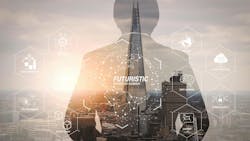AI in the Tech Industry is Here—and It’s Reshaping the Job Landscape
What you'll learn:
- How AI isn’t just replacing jobs, it’s reshaping the tech industry landscape by changing how work gets done.
- How that shift is currently driving mass layoffs at major companies like Klarna, Duolingo, and Amazon.
- How adaptation and learning to work with AI tools are becoming the key to staying relevant in the tech industry.
It’s no secret that AI is altering the tech industry’s job landscape, but the reality is more nuanced than “robots are taking our jobs.” The question of whether artificial intelligence is on track to replace workers in the tech industry currently dominates Silicon Valley, social media, and even politics.
The thought is frightening for some, while others see it as a path forward in sparking a new revolution in innovation. That notion has sparked fear in many industries over the last decade, and the technology panorama in 2025 is doing little to assuage that uncertainty.
The answer to the question above is “yes.” AI is currently impacting the technology industry through job displacement, going so far as to reshape the jobs available today and those of future opportunities. It’s inevitable.
We need only to look back at the Industrial Revolution—a period of major technological advancement that transitioned us from purely agrarian societies to industrial ones. Workers back then faced the same uncertainty that we find ourselves in today with the introduction of advanced technologies, and often expressed that fear through labor disputes, strikes, and, in some cases, limited violence.
Efficient and Innovative AI?
Many tech firms and companies are actively adopting AI technologies in the name of “efficiency” and “innovation,” which often leads to layoffs, increased workloads, and a drop in the quality of work. While AI has been adopted to automate routine tasks, its current state can result in increased pressure on workers to manage AI results, review AI-generated work, and meet shorter deadlines. We need only to look at recent headlines to see that current impact.
It's been reported that companies such as Duolingo and Klarna have laid off workers as they shift to adopt “AI-first” strategies, while Elon Musk’s DOGE employed an AI-based strategy to fire tens of thousands of federal workers (the numbers range from 22,000 to 250,000). Amazon, British Telecom, Spotify, and others are following suit as workloads transition to AI for use in automation tasks.
According to Layoffs.fyi, 150 tech companies have already laid off over 63,000 employees, and the numbers are rising. Goldman Sachs has said that AI could replace the equivalent of 300 million jobs, citing shifts in workflows, which the banking firm ultimately states could drive up global GDP by 7%.
While tech CEOs are touting productivity gains using the AI-first initiative, the workforce may not be ready to shoulder that transition, even as companies continue to implement AI across their operations.
AI or Else…
So, what does all that mean for those still working in the tech industry, and those looking to enter the workforce? The message is clear: adapt or be automated. That might sound like a heartless notion, but the tech industry is dynamic and evolves when new technologies become available. It isn’t just about replacing automated tasks; it’s about transforming how work is done.
Developers, engineers, and designers are finding that their job roles now require knowledge of AI tools and automation workflows. Those thriving in 2025 aren’t clinging to the old way of doing things. They’re integrating AI into their skill set to make themselves faster, sharper, and harder to replace.
That said, it’s not all doom and layoffs. Many companies are retraining their workers and even creating new roles focused entirely on implementing AI into their business models. Granted, that kind of support is still unbalanced, especially for those working at smaller companies. Workers who take the initiative aren’t only learning an invaluable skill set, they’re also building job security by staying relevant.
About the Author
Cabe Atwell
Technology Editor, Electronic Design
Cabe is a Technology Editor for Electronic Design.
Engineer, Machinist, Maker, Writer. A graduate Electrical Engineer actively plying his expertise in the industry and at his company, Gunhead. When not designing/building, he creates a steady torrent of projects and content in the media world. Many of his projects and articles are online at element14 & SolidSmack, industry-focused work at EETimes & EDN, and offbeat articles at Make Magazine. Currently, you can find him hosting webinars and contributing to Electronic Design and Machine Design.
Cabe is an electrical engineer, design consultant and author with 25 years’ experience. His most recent book is “Essential 555 IC: Design, Configure, and Create Clever Circuits”
Cabe writes the Engineering on Friday blog on Electronic Design.

